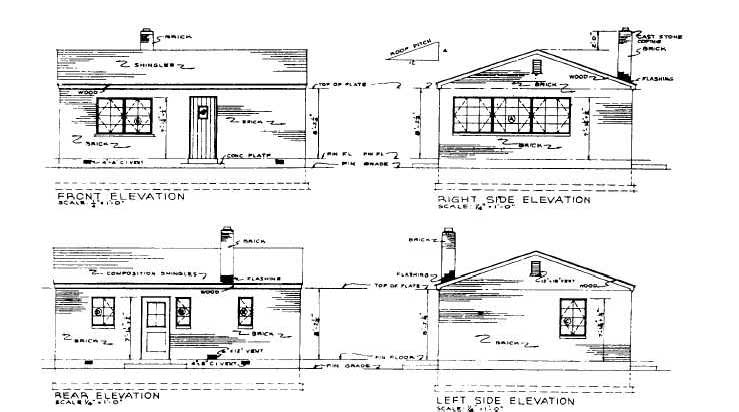partitions at the particular floor level. It also shows the number, dimensions, and arrangement of the rooms, the widths and locations of doors and windows, and the locations and character of bathroom, kitchen, and other utility features. You should carefully study figure 2-12. In dimensioning floor plans, it is very important to check the overall dimension against the sum of the partial dimensions of each part of the structure.
Elevations
The front, rear, and sides of a structure, as they would appear projected on vertical planes, are shown in elevations. Studying the elevation drawing gives you a working idea of the appearance and layout of the structure.
Elevations for a small building are shown in figure 2-13. Note that the wall surfaces of this house will consist of brick and the roof covering of composition shingles. The top of the rafter plate will be 8 feet 2 1/4 inches above the level of the finished first floor, and the tops of the finished door and window openings 7 feet 1 3/4 inches above the same level. The roof will be a gable roof with 4 inches of rise for every 12 inches length. Each window shown in the elevations is identified by a capital letter that goes with the window schedule (which we'll discuss later in this chapter).
Framing Plans
Framing plans show the size, number, and location of the structural members (steel or wood) that make up the building framework. Separate framing plans may be drawn for the floors, walls, and roof. The floor framing plan must specify the sizes and spacing of joists, girders, and columns used to support the floor. When detail drawings are needed, the methods of anchoring joists and girders to the columns and foundation walls or footings must be shown. Wall framing plans show the location and method of framing openings and ceiling heights so that studs and posts can be cut. Roof framing plans show the construction of the rafters used to span the building and support the roof. Size, spacing, roof slope, and all details are shown.
FLOOR PLANS. - Framing plans for floors are basically plane views of the girders and joists. Figure 2-14 is an example of a typical floor framing plan.

Figure 2-13. - Elevations.
Continue Reading